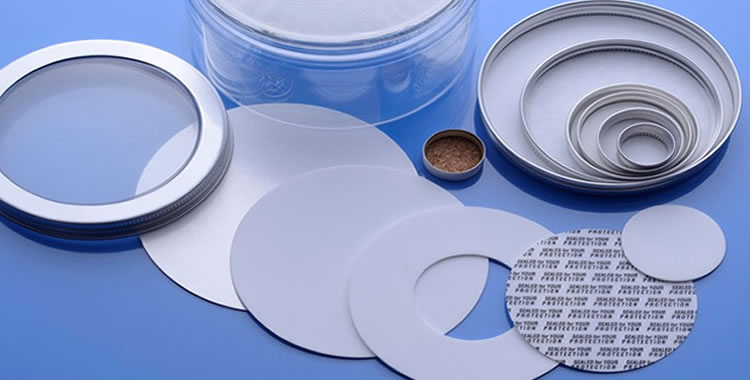
In today's fast-paced world of manufacturing and packaging, ensuring the integrity, safety, and quality of products is paramount. This blog, The Power of Protection: Exploring Induction Wads and Seals takes an in-depth look at the often-underappreciated but indispensable technology of induction wads and seals. These unassuming components play a pivotal role in maintaining product quality, safety, and security within the packaging industry.
Induction wads and seals are sophisticated yet straightforward solutions used for packaging integrity and protection. Comprising a specialized laminate structure, typically consisting of an aluminum foil layer and a heat-activated polymer layer, these seals are designed to create a secure barrier between the product and the external environment.
The magic behind induction wads and seals is rooted in the induction sealing process. It involves the use of an induction sealing machine that generates an electromagnetic field. This field, when applied to the seal placed on the container, heats the aluminum foil layer. This heat causes the polymer layer to melt and adhere to the container's rim, resulting in an airtight and watertight seal. This process ensures the protection and preservation of the product's integrity.
One of the primary functions of induction wads and seals is to provide tamper-evident security. When correctly applied, these seals establish a strong bond between the container and the seal. If any attempt is made to tamper with the product, the seal is visibly broken, indicating potential tampering. This feature is particularly significant in industries where product safety and consumer trust are critical, such as lubricants and food.
Beyond tamper-evident security, induction seals offer reliable leak-proof assurance. Whether you are packaging beverages, dairy products, condiments, lubricants or chemicals , these seals effectively prevent leaks and safeguard the product from external contaminants. This is essential for maintaining product quality and reducing waste.
Induction wads and seals find applications across a broad spectrum of industries, including pharmaceuticals, food and beverages, cosmetics, lubricants and chemicals. Their adaptability allows for the sealing of various types and sizes of containers, making them an essential component of modern packaging.
Manufacturers often take advantage of the opportunity to customize induction wads and seals with branding elements, logos, and specific messages. This not only reinforces the product's branding but also provides consumers with a clear indication of the seal's integrity. Customization options empower companies to build trust with consumers and create a strong brand identity.
The use of induction seals is crucial in ensuring the safety and hygiene of products. By providing an additional layer of protection, they reduce the risk of contamination and tampering, promoting consumer confidence and satisfaction. This is especially critical in industries where consumer health and safety are paramount.
Induction wads and seals come in various types to suit different packaging needs and container styles. Here are some common types of induction wads and seals:
One-Piece Induction Seals are single-layer seals that consist of a foil layer and a foam layer. They are commonly used for a wide range of applications, providing a basic level of protection against tampering and contamination.
Two-piece seals are composed of two layers of foil and paper layer sandwiched between them. This design offers improved barrier properties and enhanced protection, making them suitable for products that require higher levels of security.
Lift 'n' peel seals are induction seals that have a tab or lift-and-peel feature, making it easy for consumers to remove the seal without the need for additional tools like a knife or scissors. These seals are commonly used in the food industry for products like yogurt containers, Juice bottles, etc.
Venting seals have a built-in venting feature that allows the release of gas or pressure when needed. They are often used in packaging for highly corrosive chemicals to prevent the formation of a vacuum seal that can distort the container.
Manufacturers can print branding, logos, expiration dates, and other information directly onto the seal. This type of seal enhances the packaging's aesthetic appeal and provides a clear indication of product authenticity.
Peelable seals have a foil layer that can be easily peeled off from the container, providing convenient access to the product. They are often used for products like over-the-counter medicines.
Some products and containers have unique shapes or sizes, and custom-shaped seals are designed to fit precisely on those containers. This ensures a snug and effective seal for irregular packaging.
Certain industries and products require specialized sealing solutions. For instance, some seals are designed to withstand extreme temperatures, aggressive chemicals, or specific environmental conditions. These specialty seals cater to unique needs.
These seals are designed specifically for glass containers. They provide a strong, reliable seal and are commonly used for packaging products like jams and pickles.
Some seals come with foam liners that provide extra cushioning and protection. Foam liners are often used on water 5 gallons cans. The choice of induction wad or seal type depends on the specific packaging requirements, the product being sealed, and the level of security and protection needed. Manufacturers can select from these various types to ensure the integrity of their products and meet consumer expectations for safety and convenience.
As technology continues to advance, induction sealing is evolving to meet the ever-changing demands of the packaging industry. Innovations in materials and machinery are improving the efficiency and sustainability of these seals. The future holds exciting possibilities, including advancements in smart packaging and eco-friendly solutions.
While induction wads and seals often work behind the scenes in the realm of packaging, their significance cannot be overstated. They are the unsung guardians that uphold the standards of quality, safety, and transparency expected by consumers. In a world where discerning customers seek products they can rely on, these inconspicuous components assume a central role in safeguarding what matters most. Whether they are sealing a life-saving medication bottle or preserving the flavor of a beloved condiment, induction wads and seals work silently, yet powerfully, to ensure protection and trust.
